User manual

1
Spro2
Quick Start Guide

2
LEGAL INFORMATION
Copyright © 2015 ZTE CORPORATION.
All rights reserved.
No part of this publication may be quoted, reproduced, translated or
used in any form or by any means, electronic or mechanical, including
photocopying and microfilm, without the prior written permission of
ZTE Corporation.
Notice
ZTE Corporation reserves the right to make modifications on print
errors or update specifications in this guide without prior notice.
We offer self-service for our smart terminal device users. Please visit
the ZTE official website (at www.zteusa.com) for more information on
self-service and supported product models. Information on the
website takes precedence.
Visit http://www.zteusa.com to download the user manual. Just click
Support from the home page and then select your product to search
for related support information.

3
Disclaimer
ZTE Corporation expressly disclaims any liability for faults and
damages caused by unauthorized modifications of the software.
Images and screenshots used in this guide may differ from the actual
product.
Trademarks
ZTE and Spro2 logos are trademarks of ZTE Corporation.
Google and Android are trademarks of Google, Inc.
The Bluetooth® trademark and logos are owned by the Bluetooth SIG,
Inc.
Qualcomm® Snapdragon™ processors are products of Qualcomm
Technologies, Inc.
Qualcomm and Snapdragon are trademarks of Qualcomm
Incorporated, registered in the United States and other countries.
Used with permission.
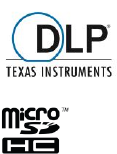
4
DLP is the trademark of Texas Instruments.
microSDHC Logo is a trademark of SD-3C, LLC.
Manufactured under license from Dolby Laboratories. Dolby, Dolby
Audio, and the double-D symbol are trademarks of Dolby
Laboratories.
Other trademarks and trade names are the property of their
respective owners.
Version No.: R1.1
Edition Time: May 5, 2015
Manual No.: 079584507194
5
Contents
Getting to Know Your Spro2 ............................................................... 7
Replacing the micro-SIM Card ......................................................... 11
Installing the microSDHC™ Card (Not Included) .............................. 14
Unmounting the microSDHC Card ................................................... 17
Charging the Battery ........................................................................ 17
Powering On/Off Your Spro2 ............................................................ 19
Restarting Your Spro2 ...................................................................... 19
Waking Up Your Spro2 ..................................................................... 20
Getting Verizon Wireless Service ..................................................... 21
Using the Touch Screen ................................................................... 22
Getting to Know the Home Screen ................................................... 25
Turning On/Off the Projector ............................................................. 33
Adjusting the Projection .................................................................... 34
Projecting a File Saved in Your Spro2 .............................................. 36
Projecting an HDMI Source .............................................................. 37
6
Projecting a File Saved in Your USB Device .................................... 40
Projecting a Source on Your Phone via Miracast (Wi-Fi Display) ..... 42
Connecting Your Spro2 to a Computer via USB ............................... 44
Connecting to a Webcam (Not Included) ......................................... 46
Enabling Mobile Data Access ........................................................... 47
Connecting to Wi-Fi® ........................................................................ 47
Sharing Your Mobile Data Connection as a Mobile Hotspot ............. 48
Using Miracast and Mobile Hotspot Simultaneously ........................ 50
For Your Safety ................................................................................ 52
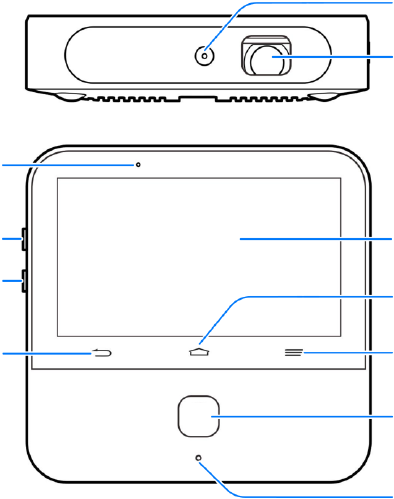
7
Getting to Know Your Spro2
Projection
Lens
Focus Sensor
Touch
Screen
Home Key
Menu Key
Back Key
Power Key
Volume Up
Key
Main
Microphone
Volume
Down Key
Indicator Light
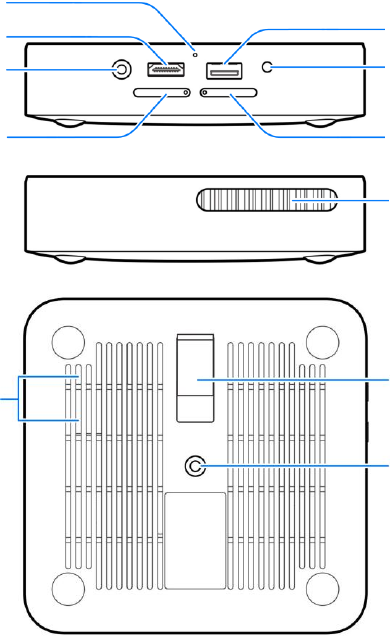
8
USB Jack
Auxiliary
Microphone
HDMI Input Port
Power Socket
micro-SIM
Card Tray
Headset Jack
microSDHC
Card Tray
Ventilation
Port
Kickstand
Speakers
Tripod
Receptacle

9
Projection Lens
Project the display on a surface.
WARNING!
Do not look directly into the projection lens or point the lens toward
people or animals’ eyes when the projector is on as this may cause
injury to the eyes.
Focus Sensor
Analyze the clarity of the projected image in order for the projector to
adjust its focus automatically.
Back Key
Touch to go to the previous screen.
Home Key
Touch to return to the HOME tab of the home screen.
Touch and hold to open the Google app or the web browser.
Menu Key
Touch to get options for the current screen.
Touch and hold to see recently used apps.

10
Volume Key (Volume Up/Down)
Press or hold to turn the volume up or down.
Power Key
Press and hold to enable or disable airplane mode, power on/off
or restart your Spro2.
Press to turn off or on the screen display.
Press twice quickly when the projector is turned on to adjust its
focus automatically.
Main Microphone / Auxiliary Microphone
Transmit your voice. The auxiliary microphone is useful for canceling
ambient noise.
Ventilation Port
Exhaust hot air when the projector is on.
WARNING!
Do not place anything near the ventilation port as this may cause
internal heat buildup. Do not place your hand near the ventilation port
as this may cause injury.

11
Tripod Receptacle
Connect a tripod (not included in the packaging).
Replacing the micro-SIM Card
A micro-SIM card is preinstalled in your Spro2, and you can replace a
new micro-SIM card if needed. The micro-SIM card can be installed or
removed while Spro2 is turned on.
WARNING!
To avoid damage to Spro2, do not use any other kind of SIM card, or
any non-standard micro-SIM card cut from a SIM card. You can get a
standard micro-SIM card from your mobile service provider.
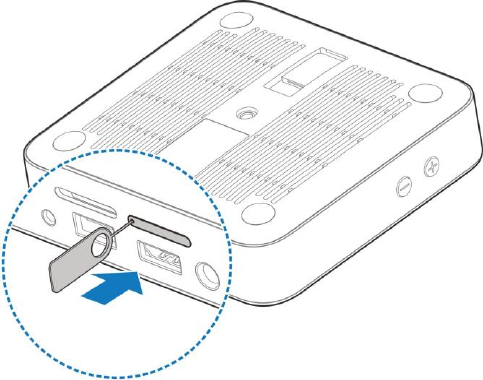
12
1. Turn your Spro2 upside down. Insert the tip of the tray eject tool
into the hole on the micro-SIM card tray and take the tray out of
the slot.
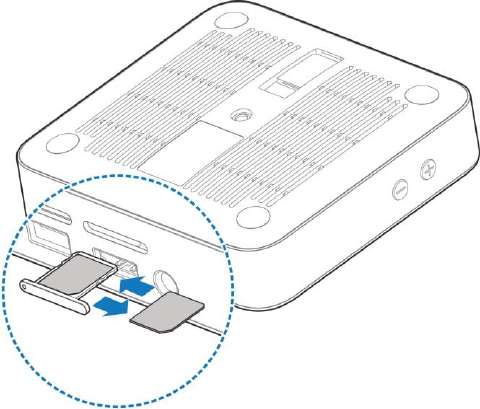
13
2. Remove the micro-SIM card on the tray and replace a new one.
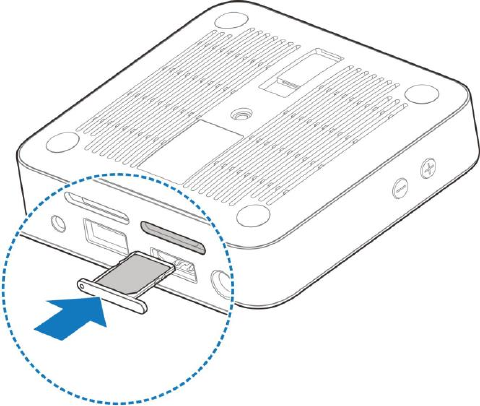
14
3. Carefully install the tray back.
Installing the microSDHC™ Card (Not Included)
A microSDHC card can be installed or removed while Spro2 is on.
Before removing the microSDHC card, you need to unmount it. See
Unmounting the microSDHC Card on page 17.
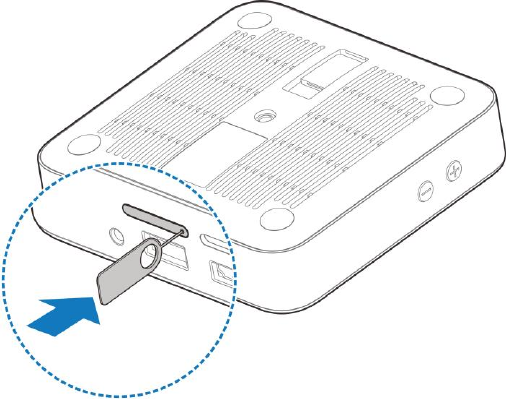
15
1. Turn your Spro2 upside down. Insert the tip of the tray eject tool
into the hole on the microSDHC card tray and take the tray out of
the slot.
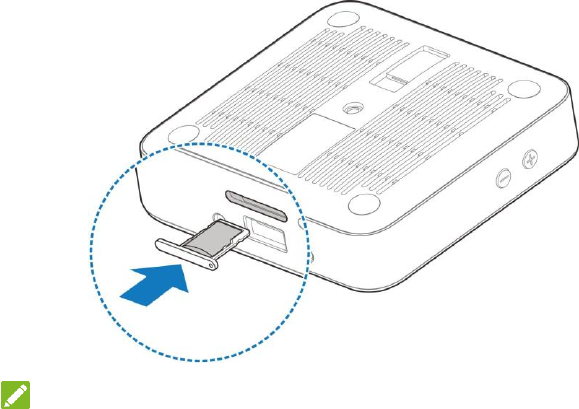
16
2. Place the microSDHC card on the tray as shown and carefully
install the tray back.
NOTE:
Some applications may require a microSDHC card to work
properly if it stores certain data on it. Therefore, it is recommended
that you keep a microSDHC card installed and not remove or
replace it unnecessarily.

17
Unmounting the microSDHC Card
To prevent damage to data stored on the microSDHC card, unmount
the card before removing it from Spro2.
1. From the SETTINGS tab of the home screen, touch System >
Device > Storage > Unmount SD card.
2. At the prompt, read the warning and touch OK to continue.
3. When the Unmount SD card menu changes to Mount SD card,
you can now safely remove the microSDHC card from Spro2.
Charging the Battery
You should fully charge the battery before using Spro2. Out of the box
the battery should have enough power for Spro2 to turn on.
WARNING!
Use only ZTE-approved chargers and cables. The use of
unauthorized accessories may cause damage.
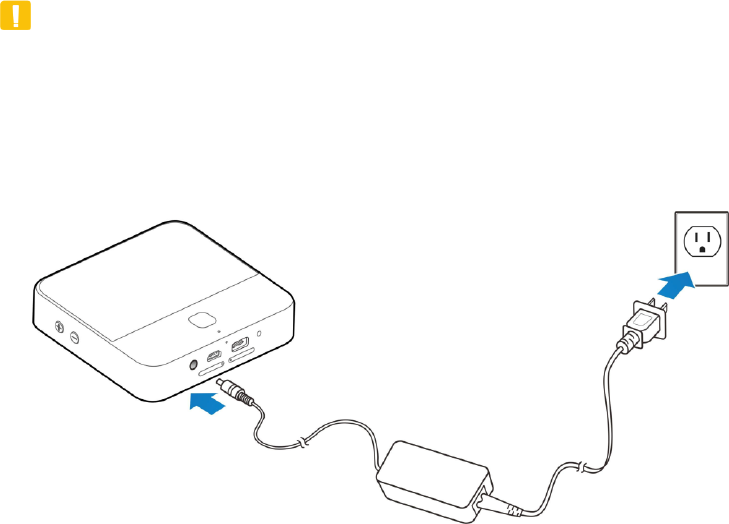
18
CAUTION:
Do not try to remove or change the built-in rechargeable battery in
your Spro2 by yourself. By doing so will violate the warranty policy
from ZTE. Contact customer service for support.
1. Plug the AC adapter into the power socket on your Spro2 and then
put the plug into an electrical outlet.
2. Disconnect the adapter when the battery is fully charged.

19
NOTE:
If the battery is extremely low, you may not be able to power on Spro2
even when it is charging. Allow Spro2 to charge longer and try again.
Contact the customer service if you still cannot power on Spro2 after
prolonged charging.
Powering On/Off Your Spro2
Ensure that the battery is charged.
Press and hold the Power Key to turn on your Spro2.
To power it off, press and hold the Power Key to open the options
menu. Touch Power off and then touch OK.
Restarting Your Spro2
If the screen freezes or takes too long to respond, try pressing and
holding the Power Key for about 10 seconds to restart Spro2.

20
Waking Up Your Spro2
Your Spro2 automatically goes into sleep mode when it is not in use
for certain time. The touch screen is turned off to save power and the
keys are locked to prevent accidental operations.
You can wake up your Spro2 by following the instructions below.
1. Press the Power Key to turn the touch screen on.
2. Touch and hold any area of the screen to unlock Spro2.
NOTE:
If you have set an unlock pattern, a PIN or a password for your Spro2,
you’ll need to draw the pattern, or enter the PIN/password to unlock
your Spro2.

21
Getting Verizon Wireless Service
Your Spro2 has a Verizon Wireless micro-SIM card already inserted.
You can add Spro2 to your existing Verizon Wireless account or sign
up for a new Verizon Wireless account via the following methods:
1. Talk with your Verizon sales representative or call 1-800-922-0204
to activate your Spro2.
NOTE:
You can find the Device ID and SIM ID on the box label for
activation.
2. Turn on your Spro2 and the device will automatically prompt you to
sign up for a Verizon Wireless data plan. Follow the on-screen
instructions to sign up.
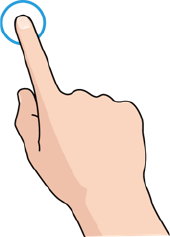
22
Using the Touch Screen
Your Spro2’s touch screen enables you to control actions through a
variety of touch gestures.
Touch
When you want to type using the onscreen keyboard, or select
items on the screen such as onscreen buttons, applications and
settings icons, simply touch them with your finger.
Touch and Hold
To open available options for an item (e.g. a link in a web page),
simply touch and hold the item.

23
Swipe or Slide
To swipe or slide means to quickly drag your finger vertically or
horizontally across the screen.
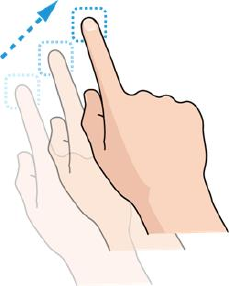
24
Drag
To drag, press and hold your finger with some pressure before
you start to move your finger. While dragging, do not release your
finger until you have reached the target position.
Pinch
In some apps (such as Maps, web browser, and Gallery), you can
zoom in and out by placing two fingers on the screen at once and
pinching them together (to zoom out) or spreading them apart (to
zoom in).
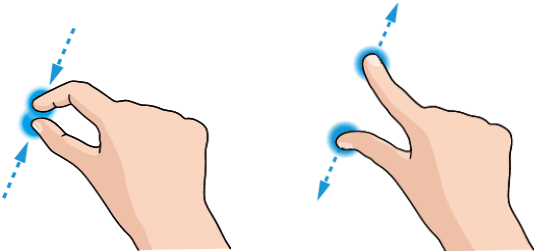
25
Rotate the screen
For some screens, you can automatically change the screen
orientation from landscape to portrait by turning Spro2 sideways.
Getting to Know the Home Screen
The home screen is the starting point for your Spro2’s applications,
functions, and menus. You can customize your home screen by
adding tabs, folders, or application shortcuts you need, or remove
them as you like.
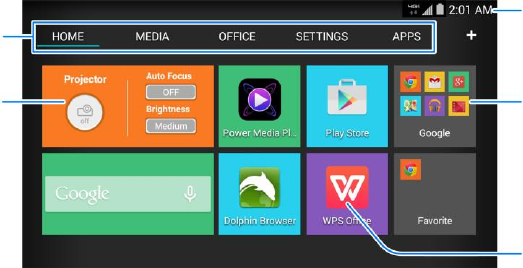
26
Navigating the Home Screen
Your home screen comes with a series of tabs.
Touch a tab to access the items in it.
Touch the APPS tab to find all your applications.
Touch other tabs to find application shortcuts, folders and widgets.
With widgets, you can manage some important functions of your
Spro2 right from the home screen.
Status bar
Tabs
Application
shortcut
Folder
Projector
widget

27
Personalizing the Home Screen
To add a tab:
Touch to add a new tab in the home screen.
To edit a tab:
Touch and hold the tab and then touch to delete the tab and all
items in it, or touch the tab name to enter a new tab name.
NOTE:
Some tabs, such as the APPS tab and the HOME tab, are
pre-configured and cannot be edited.
To add an application shortcut:
1. Touch and hold an application icon in the APPS tab or any
shortcut in any other tab.
2. Drag the item to the name of the tab that you want to put the item
in. The screen will display the content in that tab.
3. Drag the item to an empty spot in the tab and release your finger.

28
To remove an application shortcut:
1. Touch and hold an application icon in any tab other than the
APPS tab.
2. Drag the icon to (Remove) at the bottom and release your
finger.
To organize shortcuts with folders:
1. Touch and hold an application icon in any tab other than the
APPS tab.
2. Drag the icon to (Folder) at the bottom and release your finger.
A new folder is created and the icon is moved into the folder.
3. To add more shortcuts into the folder, touch and hold them and
drag them to the folder and release them.
NOTE:
To remove a shortcut from a folder, touch the folder to display its
content, and then touch and hold the shortcut and release it after
dragging it out of the folder.

29
To rename a folder:
1. Touch a folder to open it.
2. Touch twice the folder name displayed above the icons in the
folder.
3. Enter a new name and touch Done or touch any area outside the
folder to save the name.
To uninstall an application:
1. Touch and hold an application icon in the APPS tab of the home
screen.
2. Touch on the application you want to uninstall.
3. Touch OK.
NOTE:
Not all applications can be uninstalled.
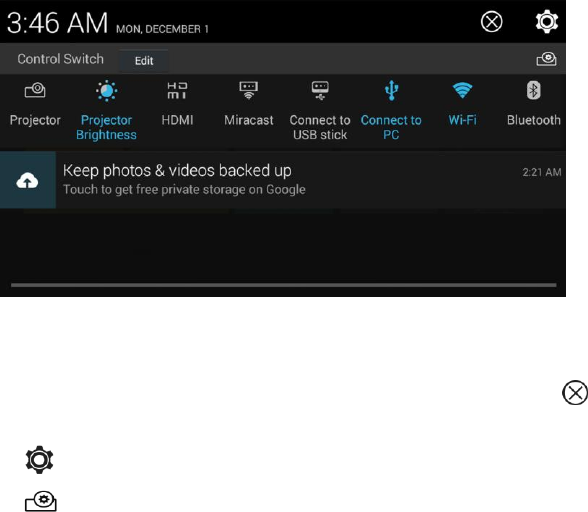
30
Using the Notification Panel
The notification panel provides quick access to alerts such as new
Gmails, new Hangouts message and software updates.
To open the notification panel, swipe down from the top of the
screen.
Swipe left or right to clear individual notifications or touch to
clear all.
Touch to access the full settings menu.
Touch to access the projector settings menu.
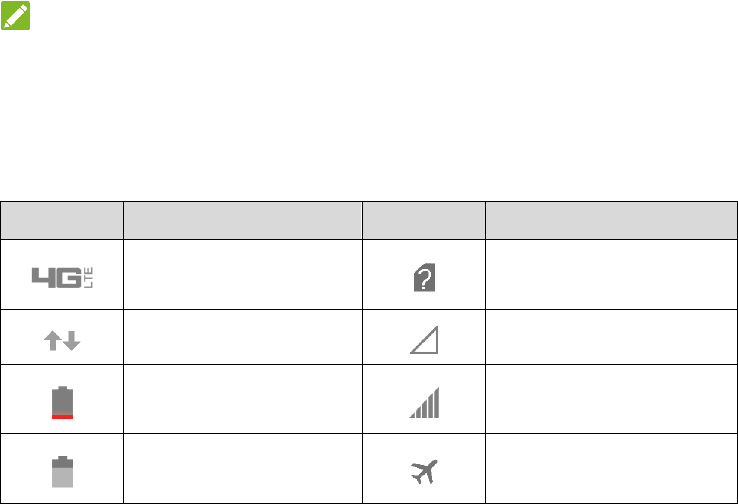
31
To close the notification panel, swipe up from the bottom of the
screen or touch the Back Key.
Touch the function icons below Control Switch to turn on or off
designated features directly.
NOTE:
Slide left or right on the function icons to find all icons.
Status and Notification Icons
Your Spro2 will tell you exactly what’s going on by showing you
simple icons. Here’s what they mean.
Indicator
What it means
Indicator
What it means
4G LTE connected
No micro-SIM card
inserted
Mobile data in use
No signal
Battery low
Signal strength
Battery partially
drained
Airplane mode
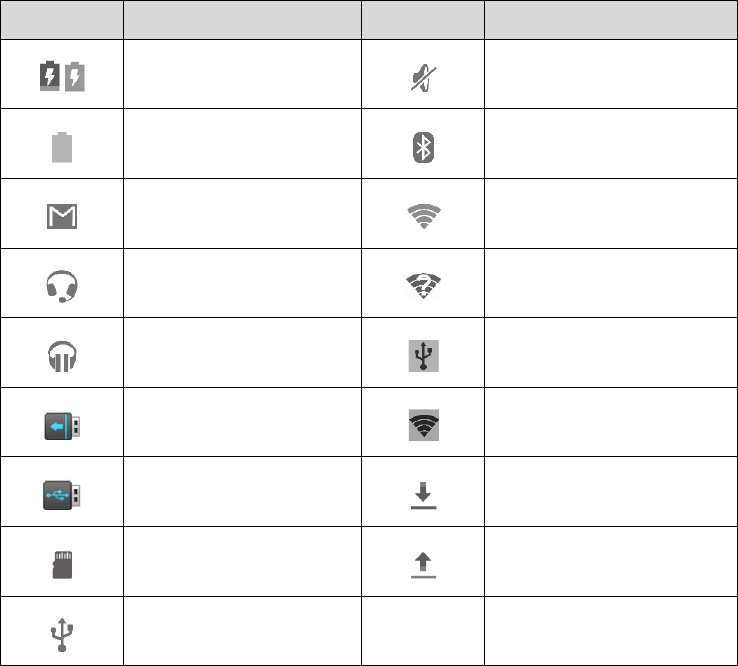
32
Indicator
What it means
Indicator
What it means
/
Battery charging
Silent mode
Battery full
Bluetooth on
New Gmail™
message
Connected to a
Wi-Fi® network
Wired headset
connected
Open Wi-Fi network
detected
Music playing
USB tethering on
Unmount external
USB device
Mobile hotspot on
External USB
device connected
Downloading data
microSDHC card
safely unmounted
Sending data
USB connected
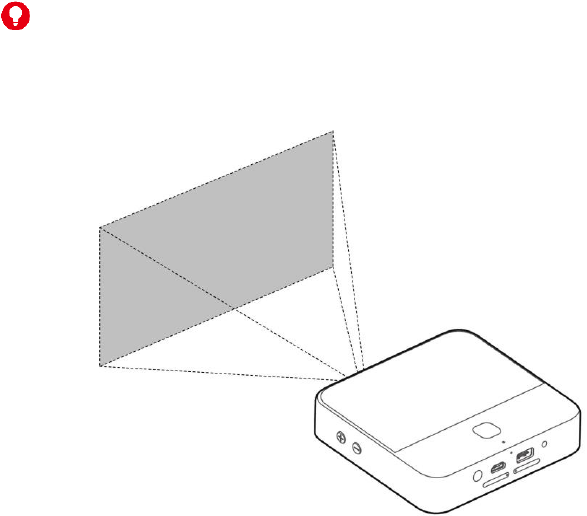
33
Turning On/Off the Projector
You can use the projector embedded in your Spro2 to project the
display onto large surfaces.
WARNING!
Do not look directly into the projection lens or point the lens toward
people or animals’ eyes when the projector is on as this may cause
injury to the eyes.

34
There are several ways that you can turn on or off the projector.
When your Spro2’s screen is turned on, swipe up or down using
THREE fingers on the screen to turn on or off the projector.
Drag the status bar down from the top of the screen and touch
Projector below Control Switch.
From the HOME tab of the home screen, touch the round button
on the Projector widget.
From the SETTINGS tab of the home screen, touch Projector >
Control and then touch the switch next to Projector in the
Projector settings screen.
NOTE:
For best results, project onto a non-reflective white flat display surface
at a 90° angle to Spro2’s touch screen. The projection distance of
Spro2 is about 3 to 12 feet.
Adjusting the Projection
When the projector is on, you can adjust projection focus, keystone
distortion and projection brightness.

35
To adjust projection focus:
1. Touch the Home Key > SETTINGS tab > Projector > Image.
2. In the Focus section, turn on automatic focus or touch “+” and “-”
to make manual adjustment.
NOTE:
You can also press the Power Key twice quickly to adjust projection
focus automatically.
To adjust keystone distortion:
You can adjust keystone distortion to correct image during a tilted
projection.
1. Touch the Home Key > SETTINGS tab > Projector > Image.
2. In the Keystone section, turn on automatic adjustment or touch
“+” and “-” to make manual adjustment.
To adjust projection brightness:
1. Touch the Home Key > SETTINGS tab > Projector > Image.
2. In the Brightness section, select the brightness level.

36
Projecting a File Saved in Your Spro2
You can project a file stored in your Spro2.
1. Open the file you want to project. For example, to open image files,
touch the APPS tab on the home screen and touch Gallery. Then
touch the album and the image to display it in full screen.
2. Turn on the projector.
3. Adjust the projection distance and place Spro2 on a flat surface.
NOTE:
Press the Power Key twice quickly to adjust projection focus
automatically.
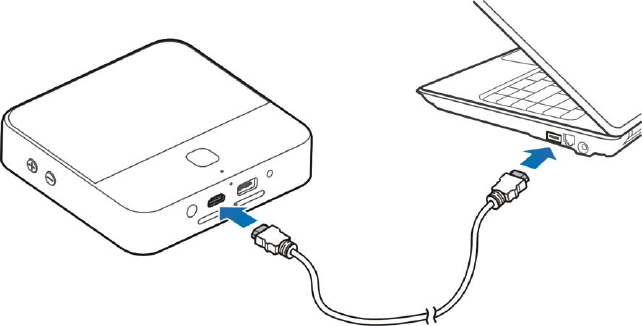
37
Projecting an HDMI Source
You can project contents via an HDMI cable when connecting your
Spro2 to a laptop/PC or TV STB (Set Top Box). If you have an Apple
device with the Lighting connector, you need to get a Lightning Digital
AV Adapter (not included in the packaging).
1. Connect your Spro2 to the laptop/PC or TV STB via the supplied
HDMI cable. (Laptop/PC or TV STB is not included in the
packaging.)

38
For Apple devices with the Lighting connector, connect the device
to the HDMI cable with the Lightning Digital AV Adapter, and then
connect the HDMI cable to Spro2.
2. Turn on the projector.
3. Swipe down the status bar at the top of the screen and touch
HDMI to highlight it.
4. Operate your laptop/PC, TV STB, or Apple device to select the
content you want to watch.
NOTES:
If your laptop/PC has other kinds of output ports, such as VGA
port, DVI port, DisplayPort and Mini DisplayPort, get a proper
adapter to connect the laptop/PC with your Spro2.
The maximum resolution of the HDMI source supported by Spro2
is 1080p (1920 × 1080 pixels). When projecting an HDMI source,
the maximum resolution of the projection screen is 720p (1280 x
720 pixels).
Press the Power Key twice quickly to adjust projection focus
automatically.
39
If the HDMI source cannot be projected properly when you use a VGA
to HDMI adaptor to connect your laptop/PC with Spro2, please follow
the instructions below.
Use an adaptor which supports 720p output.
Set the screen resolution of your laptop/PC to 1280 × 720 pixels
(for a Windows XP or Windows 7 laptop/PC), or right-click on the
desktop and select Graphics Options > Panel Fit > Maintain
Display Scaling (for a Windows 7 laptop/PC).
Set the screen refresh rate of your laptop/PC to 60 Hz or below.
For a Windows XP laptop/PC, right-click on the desktop and
select Properties > Settings > Advanced > Monitor > Screen
refresh rate; for a Windows 7 laptop/PC, right-click on the
desktop and select Screen resolution > Advanced settings >
Monitor > Screen refresh rate.
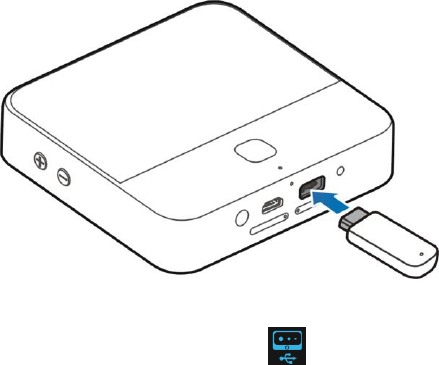
40
Projecting a File Saved in Your USB Device
You can project a file stored on the USB device such as a USB flash
drive or a portable hard drive.
1. Slide the status bar down to open the notification panel and
ensure that “Connect to USB stick” is highlighted.
2. Connect your USB device to Spro2 via the USB jack.
3. Touch the Home Key > APPS tab > File Manager.
4. Touch USB DEVICE to open the file you want to project.
5. Turn on the projector.

41
NOTES:
To disconnect the USB device from your Spro2, you should open
the notification panel and touch . After Spro2 indicates that the
external USB device has been unmounted, you can remove the
USB device.
The maximum capacity of the portable hard drive supported by
Spro2 is 2 TB; the maximum capacity of the USB flash drive
supported is 64 GB.
Press the Power Key twice quickly to adjust projection focus
automatically.
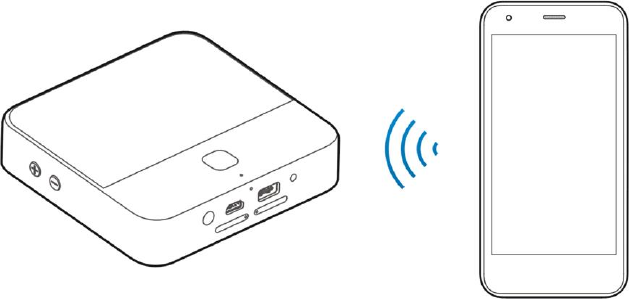
42
Projecting a Source on Your Phone via Miracast
(Wi-Fi Display)
You can display the content from compatible smart phone on your
Spro2 with a Miracast (Wi-Fi Display) link.
1. Turn on the projector.
2. Swipe down the status bar at the top of the screen and touch
Miracast to highlight it.
3. Open a Wi-Fi display application on the phone to scan for
available devices within range.

43
4. When you see the name of your Spro2 (MF97V) displayed in the
available devices section, touch the name. The phone then
automatically tries to pair with your Spro2.
5. Touch Accept on your Spro2. After successful connection, the
contents in the phone will be displayed on the projector.
6. On your phone, choose the content you want to display.
NOTES:
To end the Miracast link, touch the Back Key of Spro2.
Press the Power Key twice quickly to adjust projection focus
automatically.
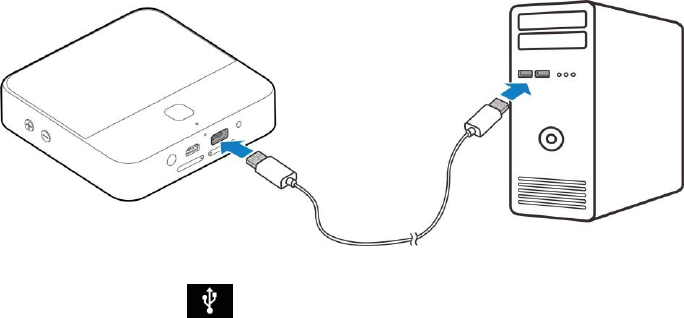
44
Connecting Your Spro2 to a Computer via USB
You can connect your Spro2 to a computer with a USB cable (not
included) and transfer music, pictures, and other files in both
directions. Your Spro2 stores these files in the internal storage or on a
removable microSDHC card.
1. Connect your Spro2 to the computer using a USB cable (not
included). Insert the end of the cable into the USB jack of Spro2
and insert the other end of the cable into an available USB port on
your computer.
2. Slide the status bar down to open the notification panel and touch
"Connect to PC" to highlight it.

45
3. Open the notification panel and touch Connected as … or
touch the Home Key > SETTINGS tab > System > Device >
USB mode.
4. Choose one of the following options:
Install driver: Install the driver needed for some USB
connection modes (such as MTP). You only need to install the
driver on the same PC once.
NOTE:
You can also install the driver on PC by running the executable
file in the new CD-ROM drive.
Media device (MTP): Transfer media files on Windows® or
Mac®.
NOTE:
For Windows XP, please install the drivers and Media Player
11 (or later version) when you use Media device (MTP) for the
first time.
5. When you are done, disconnect your Spro2 with the computer.
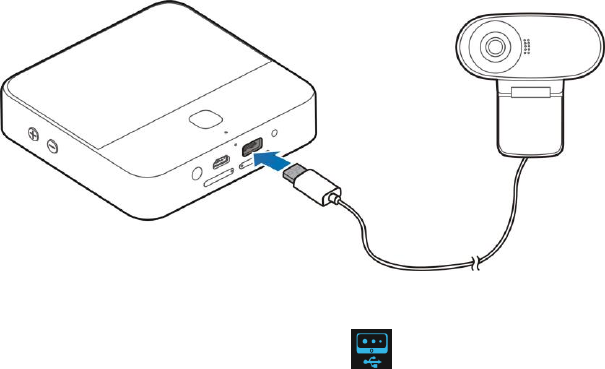
46
Connecting to a Webcam (Not Included)
You can connect a webcam to Spro2 via the USB jack and have video
calls by using a video chat app such as Google Hangouts and Skype.
1. Slide the status bar down to open the notification panel and
ensure that “Connect to USB stick” is highlighted.
2. Connect a webcam to Spro2 via the USB jack.
3. Open a video chat app to make a video call.

47
NOTES:
You can download and install camera apps on Spro2 to get more
functions, such as picture taking and video recording.
Not all webcams are supported by Spro2. Please refer to the
webcam manual for detailed instructions.
Enabling Mobile Data Access
Before using your Spro2 to access the mobile network, you need to
enable the data access.
1. Touch the Home Key > SETTINGS tab > System > Network >
Mobile networks.
2. Check Data enabled to enable data access over the mobile
network.
Connecting to Wi-Fi®
Wi-Fi is a wireless networking technology that can provide Internet
access at distances of up to 100 meters, depending on the Wi-Fi
router and your surroundings.

48
To turn Wi-Fi on and connect to a Wi-Fi network:
1. Touch the Home Key > SETTINGS > System > Network > Wi-Fi.
2. Slide the Wi-Fi switch to the ON position to turn on Wi-Fi.
3. Touch a network name to connect to it.
4. If the network is secured, enter the password and touch Connect.
NOTE:
Your Spro2 automatically connects to previously used Wi-Fi networks
when they are in range.
NOTE:
To connect to a Wi-Fi router that supports WPS, touch on
Spro2’s Wi-Fi menu and press the WPS button on your router.
Sharing Your Mobile Data Connection as a Mobile
Hotspot
You can share your Spro2’s data connection with other devices by
turning your Spro2 into a mobile Wi-Fi hotspot. The feature needs
data connection on a mobile network and may result in data charges.

49
NOTE:
When the mobile Wi-Fi hotspot feature is enabled, you cannot access
the Internet via Wi-Fi connection with Spro2. You can still remain
connected to the Internet via mobile data network.
1. Touch the Home Key > SETTINGS tab > System > Network >
Mobile Hotspot.
2. If necessary, touch CONFIGURE to rename or secure Mobile
Hotspot.
3. Slide the switch to turn on Mobile Hotspot.
4. On another device, locate your Spro2 via Wi-Fi and connect with
it.
Or, if the device supports Wi-Fi Protected Setup, touch the WPS
icon on the device, and then touch on your Spro2.
To stop sharing your data connection, turn off Mobile Hotspot.
NOTE:
You can also slide the status bar down to open the notification panel
and touch Hotspot to turn on or off Mobile Hotspot.

50
Using Miracast and Mobile Hotspot Simultaneously
You can use the projector via a Miracast link and share your mobile
data with other devices at the same time.
1. Turn on the Mobile Hotspot function and configure the hotspot
name and security options.
2. Turn Miracast on.
3. Connect your phone or device to Spro2 via Miracast or Mobile
Hotspot as you need.
To use Internet connection shared by Spro2, search for
hotspots and connect to the one with the name starting with
“DIRECT-" using your device’s Wi-Fi feature. The password is
the same as the one you set for Mobile Hotspot.
To project content from your device via Miracast, connect to
Spro2 using your device’s Wi-Fi Display or Cast Screen feature.
NOTES:
If your device has been connected to the hotspot, it will be
disconnected when you turn Miracast on. You need to search for
hotspots and reconnect to the one with the name starting with
“DIRECT-”.
51
Your device must support Wi-Fi in the 5 GHz band to use the
hotspot or Miracast while Spro2’s Mobile Hotspot and Miracast
are both on.
While the Miracast link is not active, at most 10 devices can
connect to the hotspot; while the Miracast link is active, at most 5
devices can connect to the hotspot (or 4 devices if the Miracast
link is used by another device).
With Miracast active, your hotspot cannot support some
advanced features such as user management, IP filtering, and
WPS.
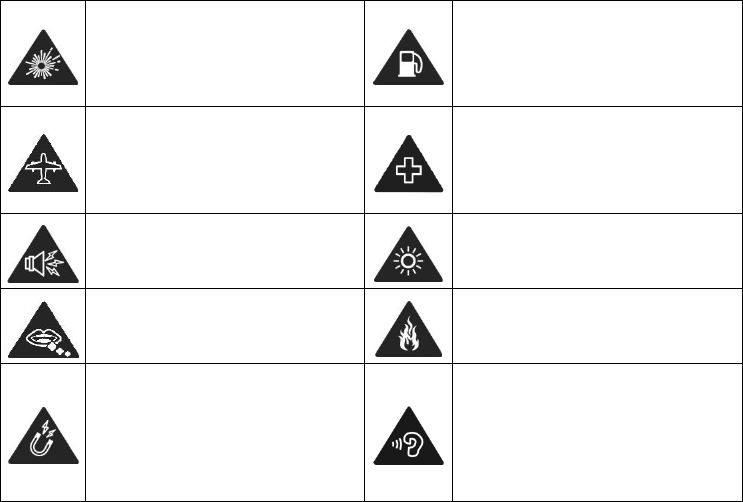
52
For Your Safety
General Safety
Turn off when near
explosive materials or
liquids.
Don’t use at gas stations.
Turn off when told to in
aircrafts and airports.
Turn off when asked to in
hospitals and medical
facilities.
Your device can produce
a loud sound.
Your device may produce
a bright or flashing light.
Small parts may cause
choking.
Don’t dispose of your
device in a fire.
Avoid contact with
anything magnetic.
To prevent possible
hearing damage, do not
listen at high volume
levels for long periods.

53
Keep away from
pacemakers and other
electronic medical
devices.
Avoid extreme
temperatures.
Avoid contact with liquids.
Keep your device dry.
Do not attempt to
disassemble your device.
Only use approved
accessories.
Radio Frequency (RF) Energy
This device is designed and manufactured not to exceed the emission
limits for exposure to radio frequency (RF) energy set by the Federal
Communications Commission of the United States.
During SAR testing, this device is set to transmit at its highest certified
power level in all tested frequency bands, and placed in positions that
simulate RF exposure in usage near the body with the separation of
10 mm. Although the SAR is determined at the highest certified power
level, the actual SAR level of the while operating can be well below
the maximum value. This is because the device is designed to
54
operate at multiple power levels so as to use only the power required
to reach the network. In general, the closer you are to a wireless base
station antenna, the lower the power output.
The exposure standard for wireless employs a unit of measurement
known as the Specific Absorption Rate, or SAR. The SAR limit set by
the FCC is 1.6 W/kg.
Tests for SAR are conducted using standard operating positions
accepted by the FCC with the device transmitting at its highest
certified power level in all tested frequency bands.
The FCC has granted an Equipment Authorization for this model
device with all reported SAR levels evaluated as in compliance with
the FCC RF exposure guidelines. SAR information on this model
device is on file with the FCC and can be found under the Display
Grant section of www.fcc.gov/oet/ea/fccid after searching on FCC ID:
SRQ-ZTEMF97V.
For this device, the highest reported SAR value for near the body is
0.79 W/kg. The highest reported SAR value for simultaneous
transmission is 0.93 W/kg.
While there may be differences between the SAR levels of various
devices and at various positions, they all meet the government
requirement. SAR compliance for body operation is based on a

55
separation distance of 10 mm between the unit and the human body.
Carry this device, at least 10 mm away from your body to ensure RF
exposure levels are compliant to or below the reported level. To
support body operation, choose the belt clips or holsters, which do not
contain metallic components, to maintain a separation of 10 mm
between the device and your body.
FCC Compliance
This device complies with part 15 of the FCC Rules. Operation is
subject to the following two conditions: (1) This device may not cause
harmful interference, and (2) this device must accept any interference
received, including interference that may cause undesired operation.
CAUTION:
Changes or modifications not expressly approved by ZTE could
violate the warranty policy. ZTE will not hold any responsibility of any
damage related to that.
NOTE:
This equipment has been tested and found to comply with the limits
for a Class B digital device, pursuant to part 15 of the FCC Rules.
56
These limits are designed to provide reasonable protection against
harmful interference in a residential installation. This equipment
generates, uses and can radiate radio frequency energy and, if not
installed and used in accordance with the instructions, may cause
harmful interference to radio communications. However, there is no
guarantee that interference will not occur in a particular installation. If
this equipment does cause harmful interference to radio or television
reception, which can be determined by turning the equipment off and
on, the user is encouraged to try to correct the interference by one or
more of the following measures:
Increase the separation between the equipment and receiver.
Connect the equipment into an outlet on a circuit different from
that to which the receiver is connected.
Consult the customer service technician for help.
CTIA Requirements
Do not disassemble or open, crush, bend or deform, puncture or
shred the battery.
Do not modify or remanufacture, attempt to insert foreign objects
into the battery, immerse or expose to water or other liquids,
expose to fire, explosion or other hazard.
57
Only use the battery for the system for which it is specified.
Only use the battery with a charging system that has been
qualified with the system per CTIA Certification Requirements for
Battery System Compliance to IEEE 1725. Use of an unqualified
battery or charger may present a risk of fire, explosion, leakage,
or other hazard.
Do not short circuit a battery or allow metallic conductive objects
to contact the battery terminals.
Replace the battery only with another battery that has been
qualified with the system per this standard, IEEE-Std-1725. Use
of an unqualified battery may present a risk of fire, explosion,
leakage or other hazard.
Promptly dispose of used batteries in accordance with local
regulations.
Battery usage by children should be supervised.
Avoid dropping the device or battery. If the device or battery is
dropped, especially on a hard surface, and the user suspects
damage, take it to a service center for inspection.
Improper battery use may result in a fire, explosion or other
hazard.
58
The device shall only be connected to CTIA certified adapters,
products that bear the USB-IF logo or products that have
completed the USB-IF compliance program.
Distraction
Driving
Full attention must be given to driving at all times in order to reduce
the risk of an accident. Using this device while driving can cause
distraction and lead to an accident. You must comply with local laws
and regulations restricting the use of wireless devices while driving.
Operating Machinery
Full attention must be given to operating the machinery in order to
reduce the risk of an accident.
Product Handling
General Statement on Handling and Use
You are responsible for how you use your device and any
consequences of its use.
You must always switch off your device wherever the use of your
device is prohibited. Use of your device is subject to safety measures
designed to protect users and their environment.
59
Always treat your device and its accessories with care and keep it
in a clean and dust-free place.
Keep the screen and projection lens clean. A dirty screen or
projection lens may slow down the device’s reaction to your
operations or lower projection image quality.
Clean your device and its accessories with a soft material such as
a cleaning cloth, or microfiber. Do not use alcohol or other
corrosive substances for cleaning or allow them to get inside.
Do not expose your device or its accessories to open flames or lit
tobacco products.
Do not expose your device or its accessories to liquids, moisture
or high humidity.
Do not drop, throw or try to bend your device or its accessories.
Do not use harsh chemicals, cleaning solvents, or aerosols to
clean the device or its accessories.
Do not paint your device or its accessories.
Do not attempt to disassemble your device or its accessories.
Do not expose your device or its accessories to extreme
temperatures. The operation temperature range for the device is
minimum of 23 ℉ and maximum of 104 ℉ (minimum – 5 ℃ and
maximum + 40 ℃).
60
Do not place your device inside or near heating equipments or
high pressure containers, such as water heaters, microwave
ovens, or hot cooking utensils. Otherwise, your device may be
damaged.
Please check local regulations for disposal of electronic products.
Children
Do not leave your device or its accessories with your young children
alone. The device is not a toy. They might accidentally damage the
device. The projection light may cause uncomfort to them or others
without parents’ direction.
The device contains small parts that may cause an injury or may
become detached and create a choking hazard.
Demagnetization
To avoid the risk of demagnetization, do not allow electronic devices
or magnetic media close to your device for a prolonged period.
Electrostatic Discharge (ESD)
Do not touch the micro-SIM card’s metal connectors.
61
Air Bags
Do not place a device in the area over an air bag or in the air bag
deployment area as an airbag inflates with great force and serious
injury could result.
Seizures/Blackouts
The device can produce a bright or flashing light. A small percentage
of people may be susceptible to blackouts or seizures (even if they
have never had one before) when exposed to flashing lights or light
patterns such as when playing games or watching video. If you have
experienced seizures or blackouts or have a family history of such
occurrences, please consult a physician. To reduce the risk of
blackouts or seizures, use your device in a well lit room and take
frequent breaks.
Repetitive Strain Injuries
To minimize the risk of Repetitive Strain Injury (RSI) when texting or
playing games with your device:
Do not grip the device too tightly.
Press the buttons lightly.
Use special features which are designed to minimize the times of
pressing buttons, such as Predictive Text.
62
Take lots of breaks to stretch and relax.
Loud Noise
This device is capable of producing loud noises, which may damage
your hearing. Turn down the volume before using headphones,
Bluetooth stereo headsets or other audio devices.
Device Heating
Your device may become warm during charging and during normal
use.
Electrical Safety
Accessories
Use only approved accessories.
Do not connect with incompatible products or accessories.
Take care not to touch or allow metal objects, such as coins or key
rings, to contact or short-circuit in the charging jack terminals.
Never puncture the surface of the device with sharp objects.
63
Faulty and Damaged Products
Do not attempt to disassemble the device or its accessories.
Only qualified personnel can service or repair the device or its
accessories.
If your device or its accessories have been submerged in water,
punctured, or subjected to a severe fall, do not use it until it has been
checked at an authorized service center.
Radio Frequency Interference
General Statement on Interference
Care must be taken when using the device in close proximity to
personal medical devices, such as pacemakers and hearing aids.
Please consult your doctor and the device manufacturer to determine
if operation of your device may interfere with the operation of your
medical device.
Pacemakers
Pacemaker manufacturers recommend that a minimum separation of
15 cm be maintained between a wireless device and a pacemaker to
avoid potential interference with the pacemaker. To achieve this, do
not use this device near your pacemaker and do not carry it near the
breast.
64
Hearing Aids
People with hearing aids or other cochlear implants may experience
interfering noises when using wireless devices or when one is nearby.
The level of interference will depend on the type of hearing device
and the distance from the interference source, increasing the
separation between them may reduce the interference. You may also
consult your hearing aid manufacturer to discuss alternatives.
Medical Equipment
Switch off your wireless device when requested to do so in hospitals,
clinics or health care facilities. These requests are designed to
prevent possible interference with sensitive medical equipment.
Aircraft
Switch off your wireless device whenever you are instructed to do so
by airport or airline staff.
Consult the airline staff about the use of wireless devices on board the
aircraft and enable airplane mode of your device when boarding an
aircraft.
65
Interference in Vehicles
Please note that because of possible interference to electronic
equipment, some vehicle manufacturers may forbid the use of your
device in their vehicles.
Explosive Environments
Gas Stations and Explosive Atmospheres
In locations with potentially explosive atmospheres, obey all posted
signs to turn off wireless devices such as your device or other radio
equipment.
Areas with potentially explosive atmospheres include fuelling areas,
below decks on boats, fuel or chemical transfer or storage facilities,
areas where the air contains chemicals or particles, such as grain,
dust, or metal powders.
Blasting Caps and Areas
Power off your device when in a blasting area or in areas posted “Turn
off two-way radios or electronic devices” to avoid interfering with
blasting operations.